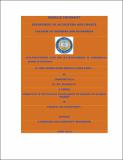| dc.description.abstract | Loan portfolio forms a substantial amount of the assets of banks and it is the predominate
source of interest income. However, when loans become non-performing, they tend to have
some serious effects on the financial health of banks. In view of the critical role banks play in
the economy of a country, it is worth finding out the causes of non-performing loan. The study
was carried out to identify the impact of non-performing loan on loan interest income, and
lending fund, focusing on Dashen Bank Mekelle Area Bank. The study also looked at the trend
of non-performing loans during the five-year period under review and the factors that account
for non-performing loan from both borrower and lending institution side. Primary and
secondary data were used in the study. Primary data gathering tools such as structured
questionnaires and personal interviews were used. Regarding secondary data, client’s files,
report directives, and annual reports of the bank were used.
The findings showed that the bank recorded huge amount of non-performing loan during the
period under consideration (2005-2009). It was identified that the non-performing loan
negatively affected the financial performance of the bank through reduction in loan interest
income and lending funds. The study identified ineffective loan monitoring and poor credit
appraisal as the major factors accounting for non-performing loan from the lending
institution side and lack of proper education on business area, lack of sufficient income,
absence of sufficient infrastructure, lack of sufficient supervision from the bank, lack of saving
account, high consumption expenditure and high interest charge were identified as the causes
for non-performing loan from the borrower side. To improve on the quality of the bank’s loan
portfolio, the management commonly uses loan rehabilitation. Some measures have been
recommended to management of the bank to minimize the existing burden of non-performing
loan those are Credit training programs, effective loan monitoring i.e. giving good on sight
supervision to client, full filling required credit staff and giving awareness to clients to
present adequate collateral and advising clients to have good knowledge on the business area
they engaged. | en_GB |


